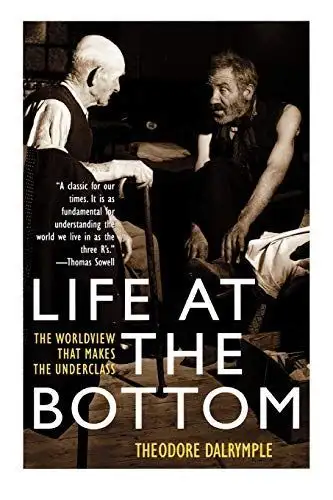
Life at the Bottom
By Theodore Dalrymple
Length: 284 pages
Rating: 9/10
First Published: 2001
Harrowing, but eye-opening. One of the bleakest books I ever read.
The book is a collection of essays published in City Journal, a US magazine, between 1994-2000 by Dr Anthony Daniels (under his pen name), a psychiatrist and prison doctor.
I picked up this book because it was in Rob Henderson’s best of 2020, and I found that Dr Daniels was compared to Orwell.
Review
Life at the Bottom and The Road to Wigan Pier share similar themes. Both books shine a light on the terrible conditions of a segment (at the bottom) of the population. Just like Orwell did for the miners in Wigan in 1937, Dr Daniels did in this book for prisoners and their victims.
The suffering of Dr Daniels’s patients is extreme. It feels inescapable to some of them too, which is heartbreaking.
Outside of his work in prisons and hospitals, Dr Daniels writes for right-wing magazines, so there’s a lot of conservative ideology scattered around the book. Some statements are downright ridiculous, like “Communist utopianism may be dead in Russia, but it molders on at the BBC – exclusively among people of the upper and middle classes, of course.” I mean, seriously?
Someone else described the writing style of these conservative magazines much better than I could. It’s “the tone of a rather embittered ageing man, a bit drunk in an upmarket London bar, lamenting the ways of the world.” And generally “much better at commentary and critique than prescription, again reflecting its literary base.” Source.
What’s different about this book is that this isn’t the typical literary book. This book is rooted in real-world misery.
At midnight along this street – with the sound of rock music pounding insistently out of every club door, and each door presided over by a pair of steroid-inflated bouncers, among men vomiting into the gutters – I saw children as young as 6, unattended by adults, waiting for their parents to emerge from their nocturnal recreations.
There’s a lot of violence. It is not a peaceful bedtime read. If do you read it in bed, and you’re safe without constant threats, it will make you grateful.
The literary style does a big disservice to the book. Dr Daniels quotes Thackeray, drops French and Italian nonsense here and there. It’s tiring.
It gets logically inconsistent at times, which big claims like “The destigmatisation of illegitimacy went hand in hand with easy divorce”, which erm, data please? And then, a few chapters later, comes a situation where no-fault divorce was a massive help.
However, there are claims which make sense and have been backed by solid data, like:
My hospital being in an area of high unemployment (24 percent, in fact), there are several betting shops within a few hundred yards of its main entrance. I have never seen a female customer in any of them, and most of the customers are poor and unemployed.”
☝️ Which (sadly) studies proved again (U of Bristol) and again (NTU).
It took me about a year to get through it. I would only read it a chapter at a time because I felt like I needed time to process it.
The surgeons in my hospital saved his life; and to celebrate his recovery and discharge, he had gone straight to the pub. From there he went home, drunk, and beat up my patient’s mother.
I struggled to come up with a rating. In a way it’s a 10/10 because of the slap in the face it gives you. It rewrites your brain about how violent humans can be and how badly some people have it. But the writing style made me want to give up multiple times.
At the end of the day, it’s still an important book.
Highlights, covers, art and quotes are copyright to their respective authors.